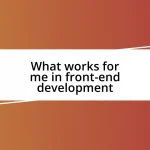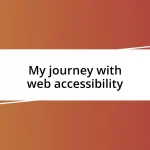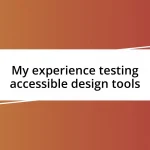Key takeaways:
- Accessibility projects are crucial for creating inclusive spaces, enhancing sense of belonging, and demonstrating societal values of equity and respect.
- Involvement of users in the design process is essential, as it ensures designs meet real needs and fosters empathy among collaborators.
- Measuring impact goes beyond data; it requires qualitative feedback and ongoing assessment to adapt and evolve accessibility features effectively.
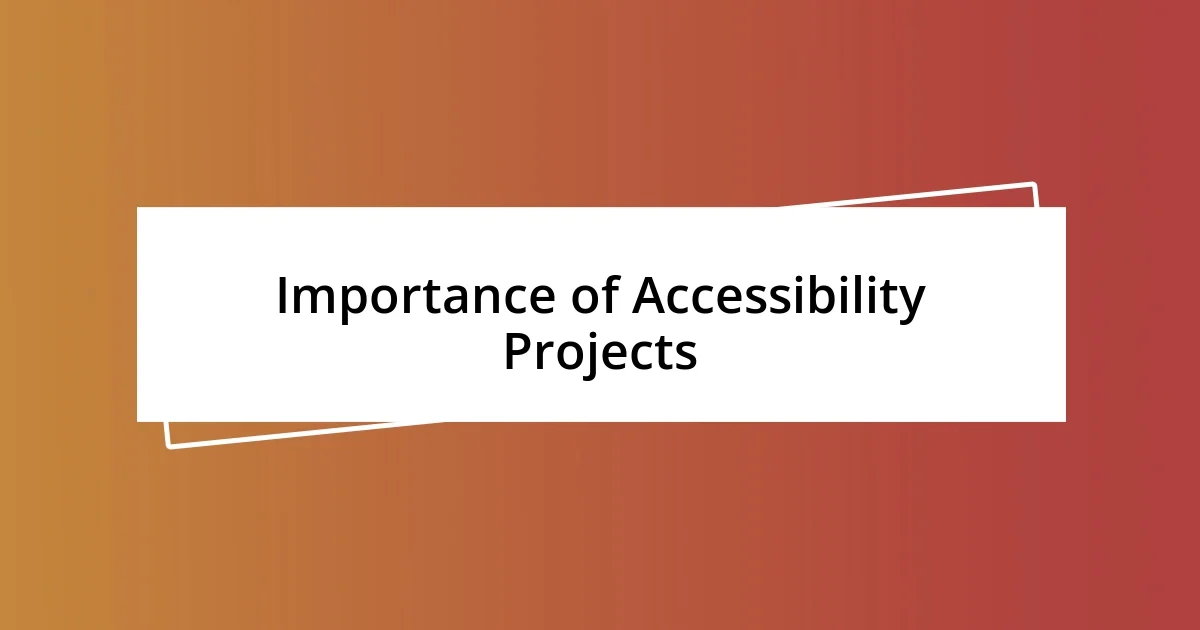
Importance of Accessibility Projects
Accessibility projects hold significant importance in creating inclusive spaces for everyone. I remember visiting a community park as a child and seeing a friend in a wheelchair struggle to access certain areas. That moment stuck with me, highlighting how critical it is for public spaces to be designed with everyone in mind. Isn’t it our responsibility to ensure that no one feels left out?
Moreover, accessibility projects not only enhance physical environments, but they also foster a sense of belonging. I once watched a family react joyfully as their child, who uses a mobility device, joined in on a playground activity designed specifically for kids with varied needs. It was a powerful reminder of how inclusivity can transform lives. How often do we consider that a simple ramp or tactile path can open up a world of play and adventure for someone?
Finally, investing in accessibility sends a strong message about our values as a society. It demonstrates a commitment to equity and respect for all individuals, regardless of their abilities. Reflecting on my experiences, I feel a sense of pride when I see businesses or communities prioritizing accessibility. Aren’t we all enriched by a more inclusive world?
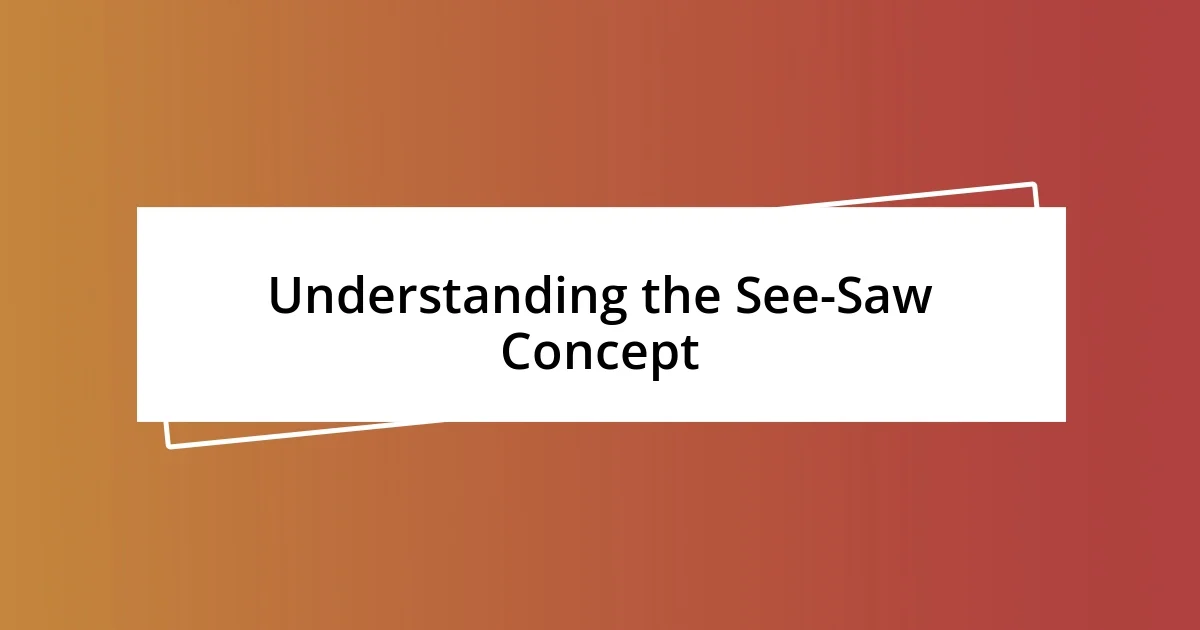
Understanding the See-Saw Concept
Understanding the See-Saw Concept revolves around the balance of accessibility and usability in designs. Think of a see-saw; if one side is much heavier than the other, it won’t function properly. In my projects, I’ve often encountered this challenge, where certain accommodations are implemented only superficially without a deeper understanding of how they interact with users’ diverse needs. It’s a gentle reminder that true inclusivity requires thoughtful integration of every element.
I recall an instance during a workshop when my team and I designed a see-saw for an inclusive playground. We learned that adjusting the height and weight distribution meant that children of different abilities could play together harmoniously. This experience taught me how critical it is to consider not just physical design, but also the emotional impact on those using the space. Can you imagine how empowering it feels for a child who typically sits on the sidelines to finally participate and laugh with their peers?
Emphasizing a user-centered approach is vital when grasping the see-saw concept in accessibility projects. During my time working with diverse communities, I found that involving users in the design process not only enhances the product but fosters empathy and understanding among all collaborators. It’s fascinating how a simple concept can translate into such profound changes in people’s lives when we get it right.
| Element | Importance |
|---|---|
| Balance | Ensures equal access and usability for everyone involved |
| Collaboration | Invites diverse voices to the design process, improving overall outcomes |
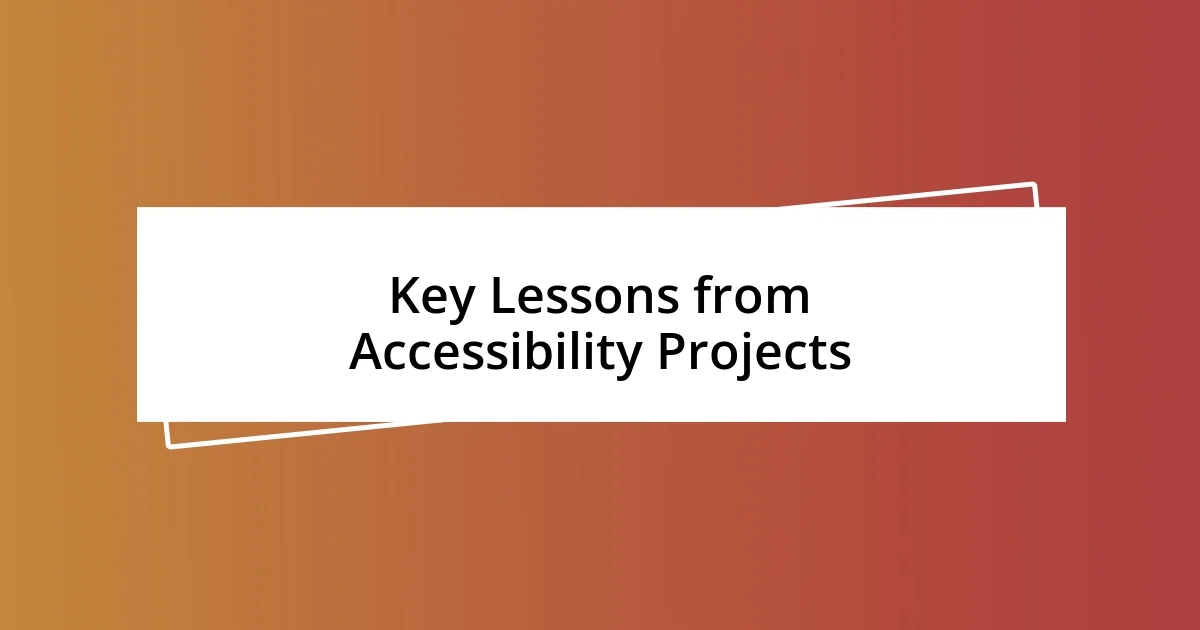
Key Lessons from Accessibility Projects
I’ve learned that involving the community in the design process yields insights that might otherwise be overlooked. During one project, we organized focus groups with individuals who had various disabilities. Listening to their experiences was eye-opening; their feedback not only helped refine our designs but also created a connection that felt genuine. It was as if each shared story added a layer of depth to the structure we were crafting, making it much more than just a physical space.
Here are some key lessons from my experiences with accessibility projects:
- Listen to Real Users: Engaging with the community amplifies their voices, ensuring that the designs truly meet their needs.
- Adaptability is Key: Flexibility in design allows spaces to evolve as user needs change, reinforcing the idea that accessibility is an ongoing process.
- Celebrate Successes: A small victory, like a child using a newly accessible playground feature, can inspire further improvements and innovations.
I often find myself reflecting on those moments when users light up because the space finally feels welcoming. These experiences serve as powerful motivators to continue striving for inclusive solutions that resonate.
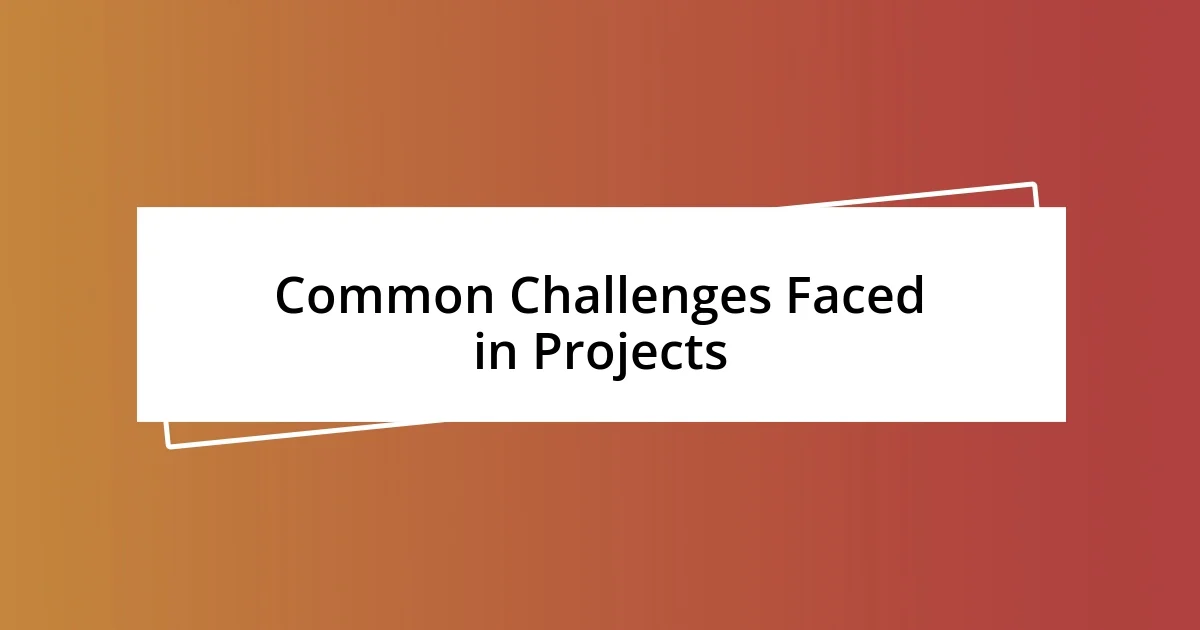
Common Challenges Faced in Projects
One major challenge I’ve often faced in accessibility projects is the disconnect between intent and implementation. For instance, during a recent playground renovation, my team set out to create wheelchair-accessible paths. However, we quickly realized that the materials we chose were difficult to navigate on wheels. Have you ever experienced the frustration of an intended solution falling flat? It was a tough lesson that taught me to always consider real-world usability, not just theoretical designs.
Another hurdle relates to budget constraints. While pursuing a project aimed at enhancing accessibility, my initial vision was extensive and ambitious. But the reality of funding forced us to prioritize certain features over others. It became a balancing act; determining how to deliver the most essential aspects without sacrificing quality. Reflecting on this, I learned that effective project management can mean making tough decisions, yet staying focused on the core mission of inclusivity is vital.
Lastly, communication issues within teams can derail progress. I’ve found that when team members come from different backgrounds or lack a clear understanding of accessibility needs, it can lead to misinterpretations and inefficiencies. I remember a moment in a team meeting when a colleague suggested a design with good intentions, but it overlooked crucial aspects for users with sensory sensitivities. How can we ensure that everyone is on the same page? Continuous education and open dialogue within the team can bridge these gaps, ultimately enriching the project’s outcome.
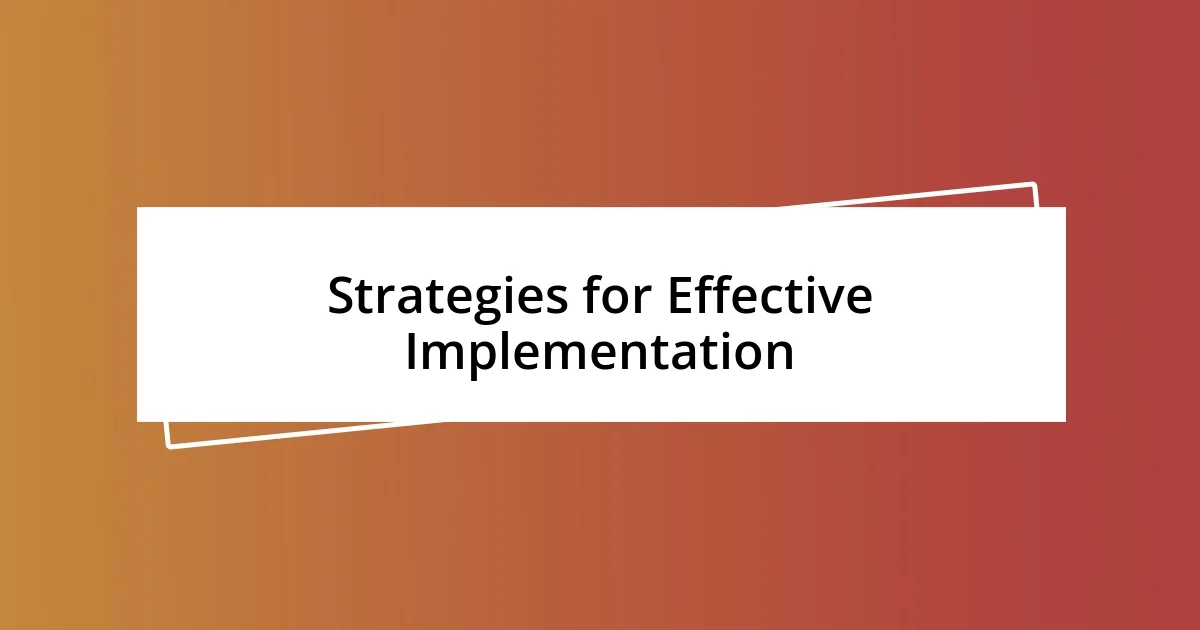
Strategies for Effective Implementation
Effective implementation of accessibility projects involves a blend of creativity and practicality. In one of my projects, we decided to prototype our designs in a temporary setup before committing to permanent changes. This approach allowed us to see firsthand how users interacted with the space and to make adjustments based on their feedback. Isn’t it fascinating how a little trial and error can lead to breakthroughs that might not have surfaced otherwise?
Another strategy that has proven essential is fostering collaboration across disciplines. During a particular project, I reached out to engineers, designers, and even occupational therapists to gather insights into how best to create adaptable features. The exchange of ideas was invigorating and brought a wealth of perspectives that enriched the designs. Have you ever noticed how diverse input can transform a concept into something truly exceptional? It’s a reminder that accessibility isn’t just a checkbox; it’s a holistic approach that thrives on varied experiences.
Lastly, meticulous planning should never be underestimated. I recall a time when we were overly excited to move forward without detailing each step, leading to confusion and misalignment. Mapping out the implementation process, with clear timelines and responsibilities, was a game changer. It not only kept us on track but also fostered accountability among team members. Who doesn’t want to feel a part of something larger, knowing exactly how their contribution matters? It’s clear to me now that structured implementation serves as the backbone of successful accessibility projects.
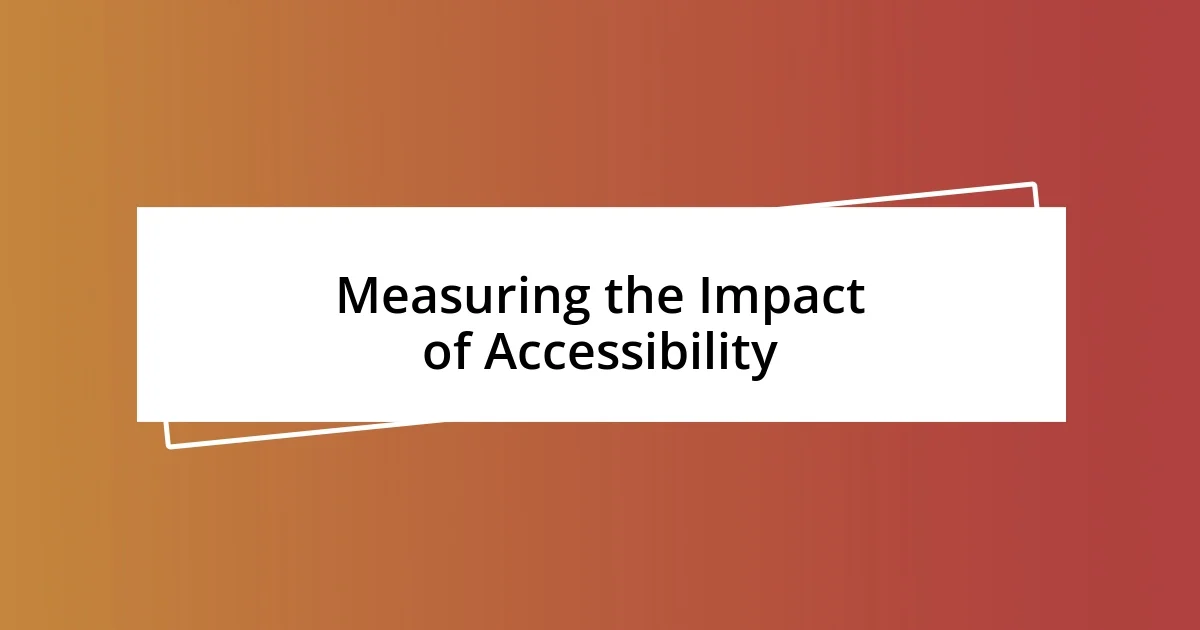
Measuring the Impact of Accessibility
Measuring the impact of accessibility is much more than checking boxes; it involves understanding the experiences of those who use the spaces we’ve created. For instance, after implementing accessibility improvements in a local park, I took the time to speak directly with park-goers. Witnessing their reactions—some felt a sense of relief and empowerment—was profoundly rewarding. It made me realize that success isn’t just about statistics; it’s about real human experiences.
Data is important, but I’ve learned that qualitative feedback often reveals deeper issues that numbers can miss. In a previous project, we relied heavily on survey results that showed high levels of satisfaction with new features. Yet, when we hosted a community feedback session, users shared nuanced frustrations that the surveys hadn’t uncovered. Have you ever found that what people say in surveys can differ from their true feelings in conversation? This taught me that engaging directly with users can illuminate gaps in our understanding and drive meaningful change.
Lastly, ongoing assessment is crucial for long-term impact. In one instance, we established regular check-in intervals post-implementation to evaluate how well our features continued to serve users. I remember one meeting where a participant pointed out a simple modification we could make to improve usability significantly. When we revisit our projects, it’s not just a formality; it’s an opportunity to listen and adapt. Isn’t it fulfilling to know that our work can evolve alongside the needs of the community? Consistent evaluation ensures that accessibility remains a living, breathing aspect of our environments.
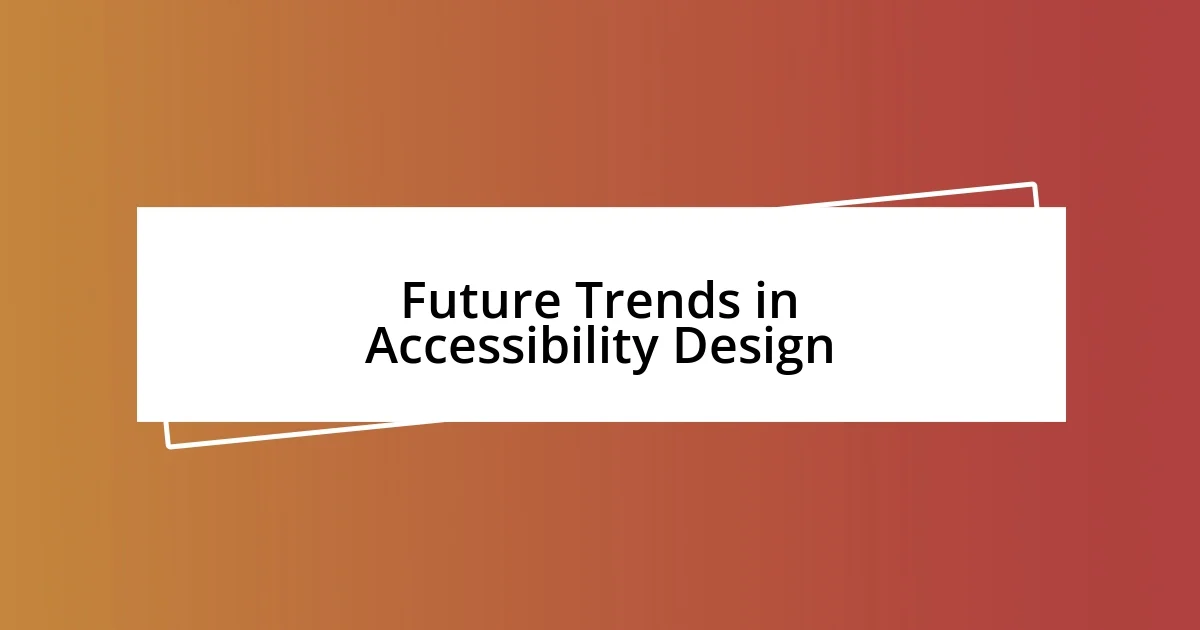
Future Trends in Accessibility Design
The future of accessibility design is veering towards a more tech-centric landscape. I recently explored the potential of augmented reality (AR) to enhance navigation for users with visual impairments. Imagine using your smartphone to provide auditory cues as you walk through a building! It struck me how such technologies could not only empower those with disabilities but also enrich the experience for all users. What if it became commonplace to have our environment speak to us, guiding us in real-time?
Another emerging trend is the shift towards personalized accessibility solutions. During a recent collaboration, we delved into adaptive technology that customizes user interfaces based on individual needs. I remember working with a client who had specific cognitive challenges; tailoring the design made a noticeable difference in their interaction with the space. Don’t you think the idea of personalization can revolutionize how we approach accessibility? It’s about recognizing that one size does not fit all, and that customization can lead to more inclusive environments.
Lastly, community engagement is poised to play an even larger role in accessibility design. I experienced this firsthand during a workshop where we invited users to share their experiences and suggest improvements. The passion and insightful feedback that emerged were nothing short of inspiring. Can you imagine the possibilities if every design decision was influenced by the people it impacts? This collaborative spirit not only strengthens community bonds but also ensures that designs are not only accessible but also truly reflective of the users’ needs.

